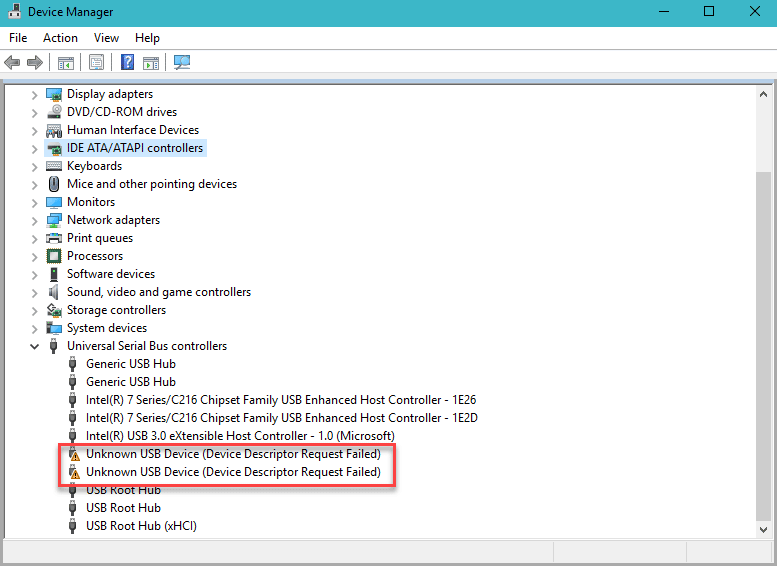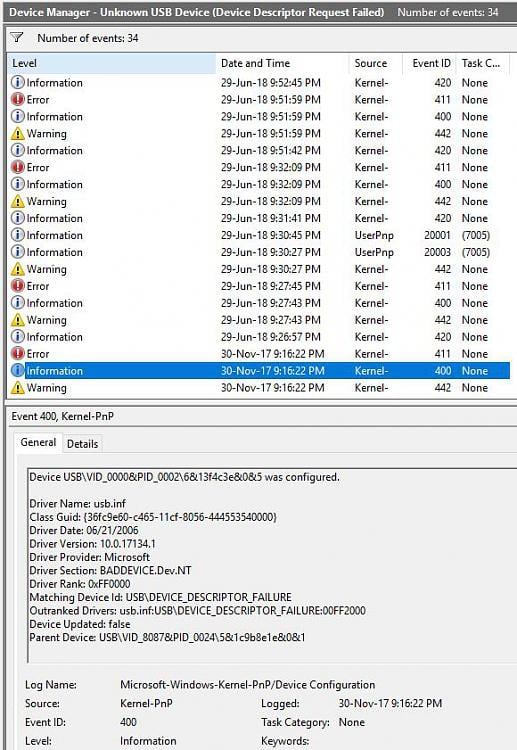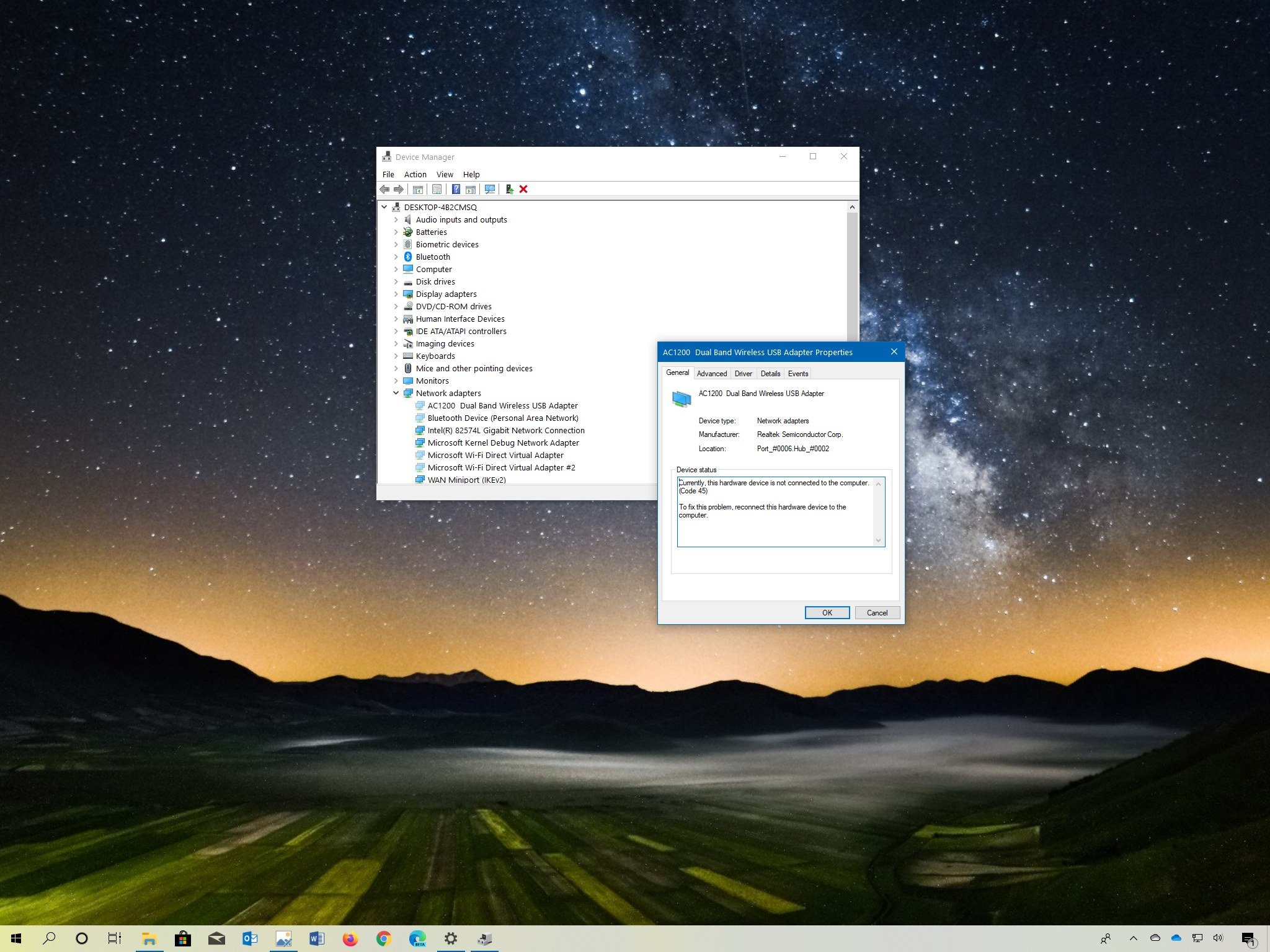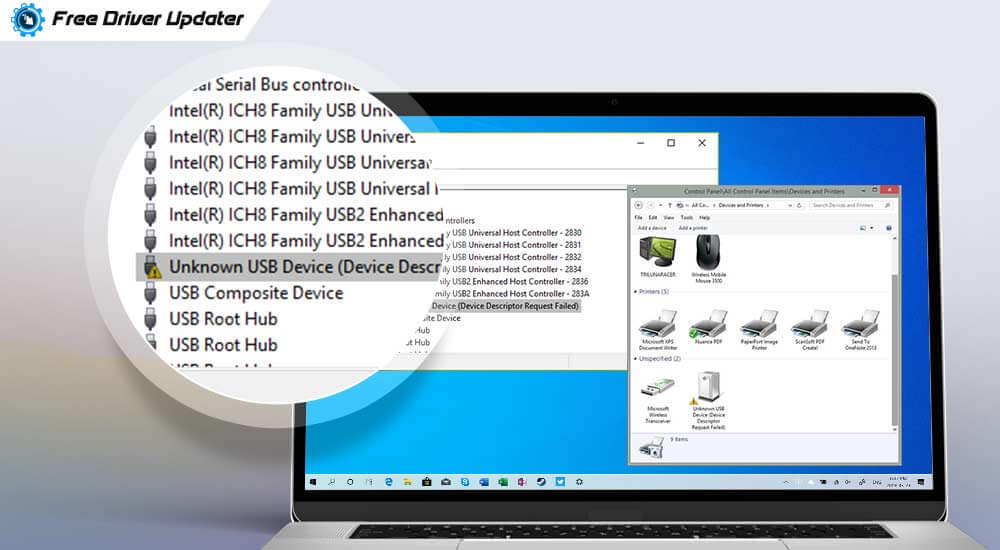Unknown Usb Device Driver Error Windows 10
Position: How Tos - How to Fix Unknown USB device (Device Descriptor Request Failed) in Windows 10/8/7?
Summary
Unknown USB Device (Device Descriptor Request Failed) is a Windows Device Manager error under the 'Universal Serial Bus controllers' section. The current device status is demonstrated as 'Windows has stopped this device because it has reported problems. A request for the USB device descriptor failed.' Unknown USB Device (Device Descriptor Request Failed) After installing Windows 10 anniversary update, I get the following error in the device manger: Unknown USB Device (Device Descriptor Request Failed) Tried uninstalling and restarting PC. Reinstalled Windows made from media tool. Disconnect USB Devices and Restart. Disconnect all USB devices and then Restart your computer. Sometimes, This error can occurs due to corrupt USB drivers then you must try this below solution. Open device manager on your PC. Now, Find Universal Serial Bus Controllers.
Your USB device cannot be recognized or reports device descriptor request failure error in Windows 10/8/7? We use USB devices all the time and it is quite frustrating when it is malfunctioned, not working or not recognized in Windows. The USB device_descriptor_failure is one of the issues we often encounter. In this article, you can find 8 reliable solutions to fix the problem and make your drive work again.
Symptoms of Unknown USB Device (Device Descriptor Request Failed)
When it comes to transferring data from one device to another, USB (Universal Serial Bus) devices might be the first choice. USB devices come in various types, such as USB flash drive, memory card, pen drive, etc. They are portable, small-sized and large in capacity, making users carry huge amount data or transfer data between devices.
The USB device descriptor is used to store information for USB drives and it is responsible for recognizing different USB devices. If it fails to work properly on Windows 10, the USB drive cannot be recognized by system and you may get errors like code 43. When you insert the USB device to your computer, you may get following message depending on your PC.
'USB device not recognized. The last USB device you connected to this computer malfunctioned, and Windows does not recognized'
'One of the USB devices attached to this computer has malfunctioned, and Windows does not recognize it.'
'Try reconnecting the device. If Windows still does not recognize it, your device may not be working properly.'
'USB DEVICE_DESCRIPTOR_FAILURE'
'Unknown USB device (device descriptor request failed) code 43'
'USB vid_0000&pid_0008 5&3a33fe6e&0&5'
If you open Device Manager, you can see the USB device which is displayed under Universal Serial Bus controllers is marked with a yellow exclamation and with message 'Unknown USB Device (Device Descriptor Request Failed)'. If you check its properties, you can see error message 'Windows has stopped this device because it has reported problems.(Code 43). A request for the USB device descriptor failed.' on the General tab.
Let's have a look at a practical scenario about this issue:
'I have a 16GB USB flash drive that I haven't used in about a year. Now I constantly get a massage saying that the device has malfunctioned. Device Manager shows similar massage. I formatted the USB drive twice now and still get the error. I tried unplugging and plugging the device, but nothing changes. I cannot find any further information about the USB drive in Device Manager except the hardware ID is USBDEVICE_DESCRIPTOR_FAILURE. What should I do to be able to access the USB device properly?'
Causes of device descriptor request failed error
Here we list some reasons why this unknown USB device (device descriptor request failed) error happens:
- Windows cannot find the description of the USB device in question.
- The USB device that reports error code 43 cannot communicate properly with computer, as there might be a connection issue.
- The device is using corrupted, damaged or outdated drivers.
- There are errors in some software or hardware components, for example, USB port is broken.
- The USB controller you are using is corrupted or unstable.
- BIOS system is not updated to the latest version.
- The USB drive is damaged, such as it contains bad sectors.
If you are troubled by this issue now and have no idea how to fix it. Just continue reading the rest part which will present a couple of methods to help you troubleshoot this issue without losing data.

Method 1: Check USB device & connection status
The first move to fix the issue should be making sure the USB device and connection is in good condition. If there is not hardware issue, you need to move to other solutions in this post.
Step 1 Unplug the USB device which reposts not recognized error and insert it to another USB port to see if it can be recognized properly by Windows. This can make sure if the issue is caused by damaged port.
Step 2 Insert the device to a different computer to check if the USB device descriptor error is causes by PC itself.
Step 3 Remove power plug from your laptop. Then restart computer and insert the USB device. Then check if the issue can be solved.
Method 2: Use Hardware and Device troubleshooter to fix USB device descriptor failure
If your computer has installed Windows 10 Creator Update, you can try the new troubleshooting tool to fix the problem. It is a Windows built-in universal troubleshooting tool and it can be used to check and repair various system problems.
Step 1 Click 'Start' menu and select the Settings icon.
Step 2 On the popup-up window click Update & Security option.
Step 3 Click 'Troubleshoot' on the left pane and look for Hardware and Devices option on the right pane.
Step 4 Click button 'Run the troubleshooter' and wait for the troubleshooter to finish. If any problems are found, it will fix them automatically.
Method 3: Uninstall and update the USB driver in Device Manager
The USB device descriptor failure issue usually has something to do with problematic USB drivers, for example, USB drivers on your computer might be outdated, corrupted, missing or broken. Therefore, you can try updating USB driver to fix the issue.
Step 1 Open Device Manager. Press Windows key and R together to open Run dialog box. Type devmgmt.msc in Run and click OK to open Device Manager.
Step 2 Browse the list and expand category Universal Serial Bus Controllers. Then you can locate the malfunctioned USB drive which is tagged with a yellow sign and named with 'Unknown USB Device (Device Descriptor Request Failed)'.
Step 3 Right-click on it and select Uninstall option from context menu. Once drivers are uninstalled successfully, restart computer and Windows will reinstall the device automatically.
Step 4 If Windows cannot install drivers correct, you can go to manufacturer's site of your USB drive and download the latest drivers. Then you can install drivers manually.
Method 4: Check and repair bad sectors for the malfunctioned USB device
Bad sectors are areas that cannot be read or written, if a disk contains too many bad sectors, you'll have to consider replacing it with a new one. Here we'd like to recommend free partition manager software to check and repair bad sectors on USB drive. You can download DiskGenius and follow steps below to repair damaged USB drive. It should be noted that bad sector repairing process damages data and you should back up or recover data first if you want to repair bad sectors on USB drive.
Step 1 Launch DiskGenius and you can see the USB drive in the main interface.
Step 2 Select the USB drive from the left pane and click 'Disk' menu to select 'Verify or repair Bad Sectors'.

Step 3 Click 'Start Verify' button below and the software starts to scan the USB drive.
Step 4 Complete the scanning complete, DiskGenius reports if any bad sectors have been found. If the USB drive contains bad sectors, you can click 'Repair' button to get them repaired.
Unknown Usb Device Driver Error Windows 10 Windows 7
Step 5 DiskGenius prompts repairing bad sectors damages data and you should create back up in advance. Click OK to continue.
Method 5: Disable Fast Startup to fix USB device failure
The fast startup feature relates to hibernate and shutdown, which is designed to make computer boot faster. However, some users report that this feature makes computer performs so quickly that Windows 10 cannot detect USB device and the USB device descriptor failure appears. If that is the case, you can follow these steps to turn off fast startup.
Step 1 Press 'Windows' key and 'R' key from keyboard at the same time to open Run dialog box.
Step 2 Type 'control' in searching box and click 'OK' button. This will open Control Panel.
Step 3 Type 'Power options' in the search box of Control panel and click 'Change what the power buttons do' from searching result.
Step 4 Click 'Change settings that are currently unavailable' link under Define power buttons and turn on password protection.
Step 5 Unselect 'Turn on Fast Startup (recommended)' option under Shutdown settings and click 'Save changes' button. Then restart computer and check if the USB device issue solves.
Method 6: Disable USB Selective Suspend Settings
In some cases, operating system will put the USB port in low-power mode if the USB selective suspend setting is enabled. If so, the USB drive connecting to this port won't be able to work normally and cause USB device_descriptor_failure problem. To solve the problem we can try disabling this feature via following steps:
Step 1 Open Control Panel and click System Security, and you can find and click Power Options. If you are using laptop, you can right-click on battery icon and select Power Options.
Step 2 Expand 'Show additional plans' and click 'Change plan settings' link which belongs to High performance option.
Step 3 Click 'Change advanced power settings' from the lower part.
Step 4 On the Advanced settings tab find and expand 'USB settings'. Then expand the sub-category 'USB selective suspend setting'.
Step 5 Select Disabled for both 'On battery' and 'Plugged in' settings. Click 'OK' and 'Apply' buttons and reboot computer.
Method 7: Update driver software for Generic USB Hub
Step 1 Right-click on Start menu and select 'Device Manager', and this opens Device Manager.

Step 2 Browse the list and expand option 'Universal Serial Bus controllers'.
Step 3 Right-click 'Generic USB Hub' entry and select 'Update Driver Software' from context menu.
Step 4 Now the 'Update Driver Software Generic USB Hub' window pops up and you should select 'Browse my computer for driver software'.
This option helps to locate and install driver software manually. Thus you may need to download the driver to your computer beforehand. If you cannot find drivers, you can try selecting 'Search automatically for updated driver software'.
Step 5 Select 'Let me pick from a list of device drivers on my computer'. The list will show installed driver software compatible with the device, and all driver software in the same category at the device.
Step 6 Select Generic USB Hub item and click Next button. Then wait for the installation to finish and close.
Method 8: How to recover lost / deleted files from USB flash drive in Windows?
Unknown Usb Device Error
This method can be used to retrieve lost data from damaged USB flash drive, SD card, external hard drive, HDD, virtual disk, etc. If your USB drive which cannot be recognized by Windows holds important files that do not have a backup, you should perform USB flash drive recovery in the first place.
Step 1 Install and launch DiskGenius from your computer. Then you can view the malfunctioned USB device in this software.
Step 2 Right-click on the partition or drive from which you want to recover lost data, and select 'Recover Lost Files' option.
Step 3 Select recovery mode and click 'Start' button.
To recover data from malfunctioned or not recognized USB drive, the 'Complete Recovery' mode should be selected. Also, the 'Search For Known File Types' option should be selected, because this option performs deep scanning and it is very useful when retrieving data from damaged drive.

Step 4 Preview files to check if files are correct.
You can double click a file to view file content in its original size, thus you can make sure if the file can be correctly recovered. DiskGenius supports previewing photos, documents (MS Office files, PDF, Text, etc), video and audio files.
Unknown Usb Device Driver Error Windows 10 Pro
Step 5 Recover files from USB disk by copying them to a different location. Select files you want to recover, right-click them and select 'Copy To'. Then you can specify a location to save recovered data.
Conclusion
We just mentioned a couple of solutions to fix unknown USB device (Device Descriptor Request Failed) error. We hope these methods can help you and now you can repair it on your own. Also, if the USB drive contains important data, you should apply data recovery before trying any repairing actions. If you have better solutions or any questions regarding this issue, please feel free to contact us.
In case while you are connecting the flash drive, external hard drive, printer or other USB device in Windows 10, and you are facing with error USB Device Not Recognized, this guide should help to solve the problem. This error can occur with USB 3.0 and USB 2.0 devices. The reasons why your Windows 10 operating system does not recognize the USB device can be different (there are really a lot), and there is a lot of solutions of the problem, and some will work for one user, while others — for the another. We will try not to miss anything in this guide.
Suppose when you connect a new USB device (flash drives, mouse and keyboard,external hard drive, printer or something else), you see an error in a popup:
USB device not recognized
The last USB device you connected to this computer malfunctioned, and Windows does not recognize it.
How to fix USB Device Not Recognized error in Windows 10?
First of all you need to make sure that the problem is not related to malfunctions in the USB device itself (this, at least, will save your time).
- Try to connect the problem device to another computer or laptop and check if it works there. If not, the most likely reason for the problems with the device and methods below may not fit.
- Next, try to connect the device to a different USB port.
- Disconnect the USB device that is not recognized, and turn off the computer. Pull the power plug from the wall outlet, then press and hold the power button on the computer for a few seconds — it will remove the remnants of the charges from the motherboard. You can also remove the battery (+ 3V) from the motherboard for a few minutes.
- If a lot of equipment is connected to your computer (especially in the front USB port on the PC or through a USB hub), try disabling the part of it that is not needed right now.
- Make sure that you do not exceed the total required power for USB devices. You can check value of total available and currently required power in the settings of USB hub device (Device Management -> Universal serial Bus controllers -> USB Root Hub -> Properties -> Power).
Unknown Usb Device Driver Error Windows 10 64-bit
If one of the above tips helped you, it is not necessary to continue reading this article.
USB Device Driver
Open the Device Manager console (Win + R -> devmgmt.msc). Your unknown device is likely to be found in one of the following sections of the Device Manager:
- Universal serial Bus controllers
- Other device
Right-click on your Unknown device and select Update Driver Software> Search automatically for update driver software.
When connected to the Internet, Windows will attempt to automatically find and install the appropriate driver.
In that case, when an unknown USB device with an exclamation point appears in the list of USB Controllers, try the following things:
- Right-click on the device, select Properties, then click button Roll Back Driver on the Driver tab, if it is available, and if not —Uninstall to remove the driver. Then in Device Manager click the Action ->Scan for hardware changes. Check whether your device is identified now.
- Next try to go into the properties of all devices with names Generic USB Hub, USB-root hub or USB Root Controller and on the tab Power Management uncheck Allow the computer to turn off this device to save power.
Another way, which can help when system displays USB device error code 43 in the description of the problem: for all listed in the previous section devices, try to perform the following actions: Right-click -> Update Driver Software -> Browse my computer for driver software -> Let me pick from a list of device drivers on my computer. In the list you will see the compatible driver (which is already installed).
How To Fix Driver Errors
Select it and click Next— after reinstalling the driver for the USB controller, that is connected to an unknown device, it can be recognized correctly.
USB 3.0 devices (USB flash drive or external hard drive) are not recognized in Windows 10
On laptops with Windows 10 operating system error USB device not recognized is quite common for external hard drives and flash drives, connected via USB 3.0 port.
To solve this problem, you must change the power scheme settings for your laptop. Go to the Windows Control Panel -> Power Options, select the power scheme that is used, and then click Change plan settings -> Change advanced power settings. Then, in the USB settings section disable USB selective suspend.
We hope that some of the above tips will help you to solve the problem with the error USB Device Not Recognized in Windows 10.